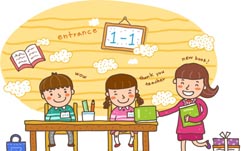Orientation
5th Grade Geography: chapter 5
Geography student’s book page 22: Orientation
(Greek educational system)
|
|
Materials for the lessonThe teacher brings in class compasses and three figurines-toys of heroes or animals. |
Layout of the classroomThis class should preferably take place during the first teaching period in the morning. Class takes place in the classroom as it is and/or in the school yard. |
|
Phase 1The teacher explains the use of a compass. S/he sets the goal of the day which is for each student to learn how to orientate him or herself.S/he then analyses the word ‘orientation’ (in Greek “προσανατολισμός») which actually means “to the orient”, to the east (in Greek προς Ανατολή).[In Greek the verb “ανατέλω” means ‘to rise’, what the sun seems to be doing on a daily basis, whereas it is the earth which moves while the sun stands still!].The teacher and the students leave the classroom and move to the school yard (or any other open space). S/he asks the students to point to the sun rising, where the light comes from, the east. Then s/he points to the west, north and south.Students touch the compasses and understand their function. |
|
Phase 2The class is randomly divided into two mixed sex groups. One group is called ‘The Invisibles’ and the other are called ‘The know-it-all’.‘The Invisibles’ have two targets. First target it to hide the three figurines (behind a tree, on top of a shelf…). Second is to draw a map of the school yard, mark north, south, east and west and give clues as to the spots of the figurines. The map should be without details, with possible traps or clues and be helpful only to viewers who can orientate themselves successfully.‘The Know-it-all’ should follow the map and find the figurines. Moving only with the help of the map is a precondition. |
|
Phase 3All return to the classroom. Students discuss their group mistakes either in hiding the figurines and in designing the map or in finding the figurines through orientation. The teacher points that orientation has to do with the relevant position of a person or an object as was in the case of the figurines. |


 SmartOWL
SmartOWL